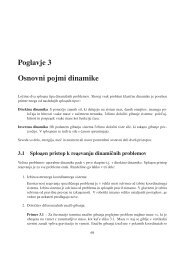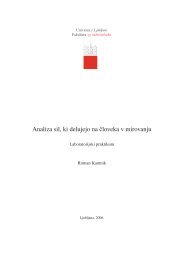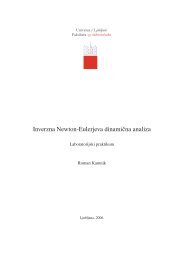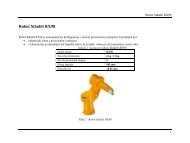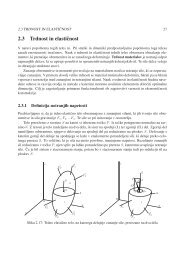The mechanical assembly dimensional measurements with the ...
The mechanical assembly dimensional measurements with the ...
The mechanical assembly dimensional measurements with the ...
You also want an ePaper? Increase the reach of your titles
YUMPU automatically turns print PDFs into web optimized ePapers that Google loves.
10666 J. Rejc et al. / Expert Systems <strong>with</strong> Applications 38 (2011) 10665–10675specific software for image acquisition and <strong>dimensional</strong> <strong>measurements</strong>of <strong>the</strong> <strong>mechanical</strong> <strong>assembly</strong> and established measuringaccuracy, repeatability and suitability of <strong>the</strong> system.2. ProtectorFig. 1. Basic structure of <strong>the</strong> protector.than AVI systems. In many cases <strong>the</strong> human measurement resultsare subjective and depend on workers’s experience. Before <strong>the</strong> AVIsystem can replace <strong>the</strong> human worker it must be tested for accuracyand measurement errors. Measurement errors can occur becauseof <strong>the</strong> object translations regarding to <strong>the</strong> video camera,inappropriate optics, badly captured images and quantization.<strong>The</strong> object translations towards <strong>the</strong> camera can result in ablurred image. Because <strong>the</strong> image sensor (e.g. CCD) is very small,a small translation of <strong>the</strong> object can result in a huge image blurring.This can be prevented <strong>with</strong> object stabilization during imagecapturing, as in our system. In case of system vibrations (Ho, 1983),<strong>the</strong> vibration isolators or <strong>the</strong> stroboscopic lightening can be used.<strong>The</strong> errors that are a consequence of inappropriate optics can bemainly found as a zone error (spherical aberration). In this effect,<strong>the</strong> light rays close and parallel to <strong>the</strong> optical axis are intersectedtoo far away from <strong>the</strong> lens. Contrary, if <strong>the</strong> rays run through <strong>the</strong>edge of <strong>the</strong> lens, <strong>the</strong>y are intersected closer. In lens systems, <strong>the</strong> effectcan be minimized using special combinations of convex andconcave lenses, as well as using aspheric lenses. Beside this effect,astigmatism must also be mentioned. In astigmatism <strong>the</strong> set ofrays, that emerge from one point out of optical axis, are copied into<strong>the</strong> set <strong>with</strong> elliptical shape. Also this effect can be minimized by<strong>the</strong> use of special lens systems. Literature (Yi-Chin et al., 2006) alsorefers to <strong>the</strong> color or chromatic error aberration caused by dispersion,because <strong>the</strong> lens for purple light has a shorter focal lengththan for <strong>the</strong> red color. <strong>The</strong> system of lenses also minimizes thiserror.<strong>The</strong> image capturing means that <strong>the</strong> outer continuous world isdigitalized and this process causes <strong>the</strong> quantization error. This isdirectly related to <strong>the</strong> image sensor resolution. Higher resolutionmeans lower error, but higher image processing time. For this reasona compromise must be found to satisfy both criteria.Using <strong>the</strong> thresholds to separate <strong>the</strong> objects from <strong>the</strong> backgroundis extremely important, meaning that <strong>the</strong> image qualityis high and <strong>the</strong> edges well expressed. For this reason it is necessaryto choose <strong>the</strong> correct lighting. Literature states that a proper lightingdesign in machine vision is a complex process and depends onmany factors. <strong>The</strong> rules can not be given, only <strong>the</strong> guidance (Tarabanis,Allen, & Tsai, 1995; Murase & Nayar, 1994). When <strong>the</strong> lightingis planned, <strong>the</strong> constructor should consider <strong>the</strong> use of varioustypes of illumination (monochromatic, polarized, focused, diffuse)and various properties of observed objects: diffusion, reflectivity,translucency and transparency. In addition, it is possible to light<strong>the</strong> object in many ways ( Miller & Friedman, 2003) and each hasits advantages and disadvantages. Also here <strong>the</strong> universal rule doesnot exist: from <strong>the</strong> front, rear, <strong>with</strong> <strong>the</strong> polarized or non-polarizedlight, direct light, <strong>with</strong> structured and stroboscopic light.In <strong>the</strong> work described in this article, we have exploited <strong>the</strong> poolof published knowledge, utilized low price hardware, developed<strong>The</strong> basic components of <strong>the</strong> protector (Fig. 1) are electrical contactsfor connecting wires, electrical switch, bimetal <strong>with</strong> <strong>the</strong> setscrew, limit and toggle element. In protector, <strong>the</strong> bimetal bendsand over <strong>the</strong> set screw exerts force on <strong>the</strong> limit element. When<strong>the</strong> limit element is pressed enough, it triggers <strong>the</strong> toggle element,which represents half of <strong>the</strong> electrical switch.<strong>The</strong> AVI system was developed for a particular protector type. Ithas nominal switch-off temperature at 400 °C <strong>with</strong> tolerances of±30 °C. In order to achieve switching <strong>with</strong>in <strong>the</strong> prescribed temperatures,<strong>the</strong> most important is <strong>the</strong> distance between <strong>the</strong> toggle elementand <strong>the</strong> limit element, marked <strong>with</strong> <strong>the</strong> letter A (Fig. 7). Fineadjustment of this distance is performed <strong>with</strong> <strong>the</strong> configurationmachines, where first <strong>the</strong> set screw is set in a way that <strong>the</strong> protectorswitches-off at room temperature. Switching event is checkedthrough electrical contacts. Since it is practically impossible andeconomically completely unjustified to adjust <strong>the</strong> set screw at<strong>the</strong> rated temperature (400 °C), <strong>the</strong> set screw is spined at roomtemperature for a certain angle in reverse and fixated <strong>with</strong> glue.This new distance A should be an appropriate distance for protectorto switch-off at <strong>the</strong> rated temperature.<strong>The</strong> described procedure is carried out on all manufactured protectors.Verification of correctness of <strong>the</strong> screw-set distance is donestatistically in <strong>the</strong> production in special ovens, where <strong>the</strong> switchofftemperatures are verified at high temperatures. <strong>The</strong>se measuredswitch-off temperatures are used to set <strong>the</strong> proper numberof reverse revolutions of <strong>the</strong> set screw during production. An identicaloven is also used in laboratory and is described later.<strong>The</strong> control, whe<strong>the</strong>r <strong>the</strong> protector system is correctly assembled,is now visually performed by <strong>the</strong> worker, which causes a possibilityof subjective evaluation. <strong>The</strong>refore, <strong>the</strong>re may be some falseassembled protectors compound in <strong>the</strong> cooking plate. As a consequence,<strong>the</strong>re is a need for introducing <strong>the</strong> AVI system, whichwould eliminate <strong>the</strong> false protectors and possibly set <strong>the</strong> appropriatedistance A. In addition, <strong>the</strong> measurement of o<strong>the</strong>r dimensions,prescribed by tolerances, can be done. <strong>The</strong>se measurement resultscan be statistically observed in a long time period.3. Automated visual inspection system<strong>The</strong> decision to develop a system for non-contact visual systemwas only acceptable, due to <strong>the</strong> structure and composition of individualprotector parts (Sato, Ishikawa, Hiraki, & Takamasu, 2002).In <strong>the</strong> class of non-contact measuring sensors are widely used triangulationlaser systems (Nguyen, 1995), that project laser light asdot, line or o<strong>the</strong>r curve. Test trials of measurement by laser triangulationline system Keyence LJ-G030 have shown, that <strong>the</strong> desireddimensions of components and <strong>the</strong> distances between <strong>the</strong>m cannot be measured, due to too small distances between <strong>the</strong> componentsof <strong>the</strong> protector.Also in video systems many problems are found. From <strong>the</strong> hardware,video camera types, lens choice and particularly <strong>the</strong> correctlighting. In measuring systems it is also very important to have<strong>the</strong> proper camera field of view, which is inversely related to <strong>the</strong>measurement accuracy, that is exhaustively discussed by Hsua,Lina, and Lee (2005).<strong>The</strong> developed AVI system for measuring <strong>the</strong> dimensions anddistances between certain components of <strong>the</strong> protector is shownin Fig. 2. It consists of a monochromatic video camera, a lens <strong>with</strong>appropriate extension rings, an adequate lighting and a <strong>mechanical</strong>



